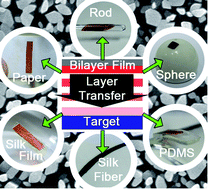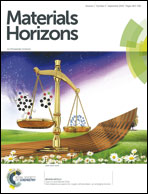Silk/molecular conductor bilayer thin-films: properties and sensing functions†
Abstract
Since their discovery, organic conductors have attracted fundamental and device physics interest due to their diverse physical properties. However, conventional electrochemical growth methods produce millimeter-sized crystals that do not translate to the fabrication of large-scale thin-film devices. Of late a chemical-vapor annealing method has been proved to be capable of growing a conductive polycrystalline layer of (BEDT-TTF)2I3 molecular conductor on the surface of soluble polycarbonate (PC) thin films in a bilayer configuration. (Here BEDT-TTF = bis(ethylenedithio)tetrathiafulvalene.) This has resulted in efficient piezoresistive organic molecular sensors. Conversely, solubility and other incompatibilities limit the direct application of the crystallite growth method to other substrates with arbitrary shape and composition. Here we report methods to circumvent these limitations. Specifically, we demonstrate the transfer of the active layer of a PC/(BEDT-TTF)2I3 bilayer film from the non-porous parent PC substrate to porous and humidity-dependent Bombyx mori silk target substrates. SEM analysis, temperature dependent resistance, and electromechanical measurements show no significant damage to the transferred (BEDT-TTF)2I3 layer. The silk/(BEDT-TTF)2I3 bilayer films exhibit additional functions that can be used for humidity sensing, electric current-driven actuators, and strain detection. Of particular significance is the piezoresistive function of the porous silk bilayer structure that allows the investigation of multi-stage diffusion processes.


 Please wait while we load your content...
Please wait while we load your content...